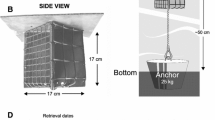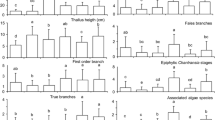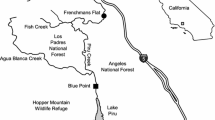Abstract
In rocky littoral communities, intense herbivory allows for the occurrence of trophic cascades where higher trophic levels influence producer communities. Invasive predators can be especially effective in imposing trophic cascades. The North American mud crab Rhithropanopeus harrisii is a recent invader in the Baltic Sea, with an expanding distribution range. Here, we document the effects of mud crab on the native invertebrate community associated with the key foundation species Fucus vesiculosus. During the initial 3 years of invasion, mud crab abundance in F. vesiculosus increased from 2 % to about 25 % of the algae being inhabited by crabs. Simultaneously, the invertebrate community underwent a major transition: Species richness and diversity dropped as a consequence of decreasing abundance and the loss of certain taxa. The abundance of gastropods decreased by 99 % and that of crustaceans by 75 %, while chironomids completely disappeared. Consequently, the community dominated earlier by herbivorous and periphyton-grazing gastropods and crustaceans shifted to a mussel dominated community with overall low abundances of herbivores. At the same time filamentous epiphytic algae prospered and the growth rate of F. vesiculosus decreased. We suggest that this shift in the invertebrate community may have far reaching consequences on ecosystem functioning. These arise through changes in the strength of producer–herbivore interaction, caused by mud crab predation on the dominating grazer taxa. This interaction is a major determinant of ecological function of ecosystems, i.e. productivity and energy flow to higher trophic levels. Therefore, the decrease in herbivory can be expected to have a major structuring role in producer communities of the rocky littoral macroalgal assemblages.





Similar content being viewed by others
References
Aarnio K, Tornroos A, Bonsdorff E (2015) Food web positioning of a recent colonizer: the North American Harris mud crab Rhithropanopeus harrisii (Gould, 1841) in the northern Baltic Sea. Aquat Invasions 10:399–413
Arroyo NL, Aarnio K, Mäensivu M, Bonsdorff E (2012) Drifting filamentous algal mats disturb sediment fauna: impacts on macro–meiofaunal interactions. J Exp Mar Biol Ecol 420:77–90
Boström C, O’Brien K, Roos C, Ekebom J (2006) Environmental variables explaining structural and functional diversity of seagrass macrofauna in an archipelago landscape. J Exp Mar Biol Ecol 335:52–73
Carlton JT (1989) Mans role in changing the face of the ocean—biological invasions and implications for conservation of near-shore environments. Conserv Biol 3:265–273
Engkvist R, Malm T, Tobiasson S (2000) Density dependent grazing effects of the isopod Idotea baltica Pallas on Fucus vesiculosus L. in the Baltic Sea. Aquat Ecol 34:253–260
Epifanio CE (2013) Invasion biology of the Asian shore crab Hemigrapsus sanguineus: a review. J Exp Mar Biol Ecol 441:33–49
Eriksson BK, van Sluis C, Sieben K, Kautsky L, Raberg S (2011) Omnivory and grazer functional composition moderate cascading trophic effects in experimental Fucus vesiculosus habitats. Mar Biol 158:747–756
Estes JA, Terborgh J, Brashares JS, Power ME, Berger J, Bond WJ, Carpenter SR, Essington TE, Holt RD, Jackson JBC, Marquis RJ, Oksanen L, Oksanen T, Paine RT, Pikitch EK, Ripple WJ, Sandin SA, Scheffer M, Schoener TW, Shurin JB, Sinclair ARE, Soule ME, Virtanen R, Wardle DA (2011) Trophic downgrading of planet earth. Science 333:301–306
Falk-Petersen J, Renaud P, Anisimova N (2011) Establishment and ecosystem effects of the alien invasive red king crab (Paralithodes camtschaticus) in the Barents Sea—a review. ICES J Mar Sci 68:479–488
Forsström T, Fowler AE, Manninen I, Vesakoski O (2015) An introduced species meets the local fauna: predatory behavior of the crab (Rhithropanopeus harrisii) in the Northern Baltic Sea. Biol Invasions 17:2729–2741
Fowler AE, Forsström T, von Numers M, Vesakoski O (2013) The North American mud crab Rhithropanopeus harrisii (Gould, 1841) in newly colonized Northern Baltic Sea: distribution and ecology. Aquat Invasions 8:89–96
Gagnon K, Yli-Rosti J, Jormalainen V (2015) Cormorant-induced shifts in littoral communities. Mar Ecol Prog Ser 541:15–30
Goecker ME, Kall SE (2003) Grazing preferences of marine isopods and amphipods on three prominent algal species of the Baltic Sea. J Sea Res 50:309–314
Gotelli NJ, Colwell RK (2011) Estimating species richness. In: Magurran AE, Mcgill BJ (eds) Biological diversity. Oxford University Press, New York, pp 39–65
Grosholz E (2002) Ecological and evolutionary consequences of coastal invasions. Trends Ecol Evol 17:22–27
Grosholz ED, Ruiz GM, Dean CA, Shirley KA, Maron JL, Connors PG (2000) The impacts of a nonindigenous marine predator in a California bay. Ecology 81:1206–1224
Gruner DS, Smith JE, Seabloom EW, Sandin SA, Ngai JT, Hillebrand H, Harpole WS, Elser JJ, Cleland EE, Bracken MES, Borer ET, Bolker BM (2008) A cross-system synthesis of consumer and nutrient resource control on producer biomass. Ecol Lett 11:740–755
Haahtela I (1984) A hypothesis of the decline of the bladderwrack (Fucus vesiculosus L.) in SW Finland in 1975–1981. Limnologica 15:345–350
Haavisto F, Jormalainen V (2014) Seasonality elicits herbivores’ escape from trophic control and favors induced resistance in a temperate macroalga. Ecology 95:3035–3045
Hänfling B, Edwards F, Gherardi F (2011) Invasive alien Crustacea: dispersal, establishment, impact and control. Biocontrol 56:573–595
Hegele-Drywa J, Normant M (2009) Feeding ecology of the American crab Rhithropanopeus harrisii (Crustacea, Decapoda) in the coastal waters of the Baltic Sea. Oceanologia 51:361–375
Hillebrand H (2009) Meta-analysis of grazer control of periphyton biomass across aquatic ecosystems. J Phycol 45:798–806
Honkanen T, Jormalainen V (2005) Genotypic variation in tolerance and resistance to fouling in the brown alga Fucus vesiculosus. Oecologia 144:196–205
Jormalainen V, Ramsay T (2009) Resistance of the brown alga Fucus vesiculosus to herbivory. Oikos 118:713–722
Jormalainen V, Honkanen T, Koivikko R, Eränen J (2003) Induction of phlorotannin production in a brown alga: Defense or resource dynamics? Oikos 103:640–650
Kangas P, Autio H, Hällfors G, Luther H, Niemi Å, Salemaa H (1982) A general model of the decline of Fucus vesiculosus at Tvärminne, south coast of Finland in 1977–81. Acta Bot Fenn 118:1–27
Korpinen S, Jormalainen V, Honkanen T (2007a) Bottom-up and cascading top-down control of macroalgae along a depth gradient. J Exp Mar Biol Ecol 343:52–63
Korpinen S, Jormalainen V, Honkanen T (2007b) Effects of nutrients, herbivory, and depth on the macroalgal community in the rocky sublittoral. Ecology 88:839–852
Korpinen S, Jormalainen V, Pettay E (2010) Nutrient availability modifies species abundance and community structure of Fucus-associated littoral benthic fauna. Mar Environ Res 70:283–292
Kotta J, Ojaveer H (2012) Rapid establishment of the alien crab Rhithropanopeus harrisii (Gould) in the Gulf of Riga. Est J Ecol 61:293–298
Leppäkoski E, Gollasch S, Gruszka P, Ojaveer H, Olenin S, Panov V (2002) The Baltic—a sea of invaders. Can J Fish Aquat Sci 59:1175–1188
Lotze HK, Worm B, Sommer U (2000) Propagule banks, herbivory and nutrient supply control population development and dominance patterns in macroalgal blooms. Oikos 89:46–58
Lotze HK, Worm B, Sommer U (2001) Strong bottom-up and top-down control of early life stages of macroalgae. Limnol Oceanogr 46:749–757
Malm T, Engkvist R, Kautsky L (1999) Grazing effects of two freshwater snails on juvenile Fucus vesiculosus in the Baltic Sea. Mar Ecol Prog Ser 188:63–71
Nilsson J, Engkvist R, Person L-E (2004) Long-term decline and recent recovery of Fucus populations along rocky shores of southeast Sweden, Baltic Sea. Aquat Ecol 38:587–598
Nurkse K, Kotta J, Orav-Kotta H, Parnoja M, Kuprijanov I (2015) Laboratory analysis of the habitat occupancy of the crab Rhithropanopeus harrisii (Gould) in an invaded ecosystem: the north-eastern Baltic Sea. Estuar Coast Shelf Sci 154:152–157
Paavola M, Olenin S, Leppäkoski E (2005) Are invasive species most successful in habitats of low native species richness across European brackish water seas? Estuar Coast Shelf Sci 64:738–750
Pace ML, Cole JJ, Carpenter SR, Kitchell JF (1999) Trophic cascades revealed in diverse ecosystems. Trends Ecol Evol 14:483–488
Paolucci EM, MacIsaac HJ, Ricciardi A (2013) Origin matters: alien consumers inflict greater damage on prey populations than do native consumers. Divers Distrib 19:988–995
Polo-Cavia N, Gomez-Mestre I (2014) Learned recognition of introduced predators determines survival of tadpole prey. Funct Ecol 28:432–439
Poore AGB, Campbell AH, Coleman RA, Duffy JE, Edgar GJ, Jormalainen V, Reynolds PL, Sotka EE, Stachowicz JJ, Taylor RB, Vanderklift MA (2012) Global patterns in the impact of marine herbivores on benthic primary producers. Ecol Lett 15:912–922
Reynolds PL, Sotka EE (2011) Non-consumptive predator effects indirectly influence marine plant biomass and palatability. J Ecol 99:1272–1281
Rönnberg O, Lehto J, Haahtela I (1985) Recent changes in the occurrence of Fucus vesiculosus in the Archipelago Sea, SW Finland. Ann Bot Fenn 22:231–244
Salo P, Korpimaki E, Banks PB, Nordstrom M, Dickman CR (2007) Alien predators are more dangerous than native predators to prey populations. Proc R Soc B Biol Sci 274:1237–1243
SAS Institute Inc (2008) SAS/STAT® 9.2 user’s guide. SAS Institute Inc, Cary
Schmitz OJ, Raymond PA, Estes JA, Kurz WA, Holtgrieve GW, Ritchie ME, Schindler DE, Spivak AC, Wilson RW, Bradford MA, Christensen V, Deegan L, Smetacek V, Vanni MJ, Wilmers CC (2014) Animating the carbon cycle. Ecosystems 17:344–359
Sergio F, Schmitz OJ, Krebs CJ, Holt RD, Heithaus MR, Wirsing AJ, Ripple WJ, Ritchie E, Ainley D, Oro D, Jhala Y, Hiraldo F, Korpimaki E (2014) Towards a cohesive, holistic view of top predation: a definition, synthesis and perspective. Oikos 123:1234–1243
Shurin JB, Borer ET, Seabloom EW, Anderson K, Blanchette CA, Broitman B, Cooper SD, Halpern BS (2002) A cross-ecosystem comparison of the strength of trophic cascades. Ecol Lett 5:785–791
Shurin JB, Gruner DS, Hillebrand H (2006) All wet or dried up? Real differences between aquatic and terrestrial food webs. Proc R Soc Lond B 273:1–9
Sieben K, Ljunggren L, Bergstrom U, Eriksson BK (2011a) A meso-predator release of stickleback promotes recruitment of macroalgae in the Baltic Sea. J Exp Mar Biol Ecol 397:79–84
Sieben K, Rippen AD, Eriksson BK (2011b) Cascading effects from predator removal depend on resource availability in a benthic food web. Mar Biol 158:391–400
Sih A, Bolnick DI, Luttbeg B, Orrock JL, Peacor SD, Pintor LM, Preisser E, Rehage JS, Vonesh JR (2010) Predator–prey naivete, antipredator behavior, and the ecology of predator invasions. Oikos 119:610–621
Snyder WE, Evans EW (2006) Ecological effects of invasive arthropod generalist predators. Annu Rev Ecol Evol Syst 37:95–122
Thomsen MS, Byers JE, Schiel DR, Bruno JF, Olden JD, Wernberg T, Silliman BR (2014) Impacts of marine invaders on biodiversity depend on trophic position and functional similarity. Mar Ecol Prog Ser 495:39–47
Vahteri P, Mäkinen A, Salovius S, Vuorinen I (2000) Are drifting algal mats conquering the bottom of the Archipelago Sea, SW Finland? Ambio 29:338–343
Vonesh JR, Kraus JM, Rosenberg JS, Chase JM (2009) Predator effects on aquatic community assembly: disentangling the roles of habitat selection and post-colonization processes. Oikos 118:1219–1229
White EM, Wilson JC, Clarke AR (2006) Biotic indirect effects: a neglected concept in invasion biology. Divers Distrib 12:443–455
Wikström SA, Kautsky L (2007) Structure and diversity of invertebrate communities in the presence and absence of canopy-forming Fucus vesiculosus in the Baltic Sea. Estuar Coast Shelf Sci 72:168–176
Worm B, Lotze HK, Boström C, Engkvist R, Labanauskas V, Sommer U (1999) Marine diversity shift linked to interactions among grazers, nutrients and propagule banks. Mar Ecol Prog Ser 185:309–314
Acknowledgments
We are grateful to Tiina Piltti, Juho Yli-Rosti, Luca Rugiu, Tiina Salo and Anneli Asplund for help in setting up, maintaining and sampling the bladderwrack common garden, and to the Archipelago Research Institute of the University of Turku for facilities and logistic help. The study was funded by the Academy of Finland (Project #251102) and the BONUS, the EU joint Baltic Sea research and development program, project BAMBI.
Author information
Authors and Affiliations
Corresponding author
Rights and permissions
About this article
Cite this article
Jormalainen, V., Gagnon, K., Sjöroos, J. et al. The invasive mud crab enforces a major shift in a rocky littoral invertebrate community of the Baltic Sea. Biol Invasions 18, 1409–1419 (2016). https://doi.org/10.1007/s10530-016-1090-9
Received:
Accepted:
Published:
Issue Date:
DOI: https://doi.org/10.1007/s10530-016-1090-9




